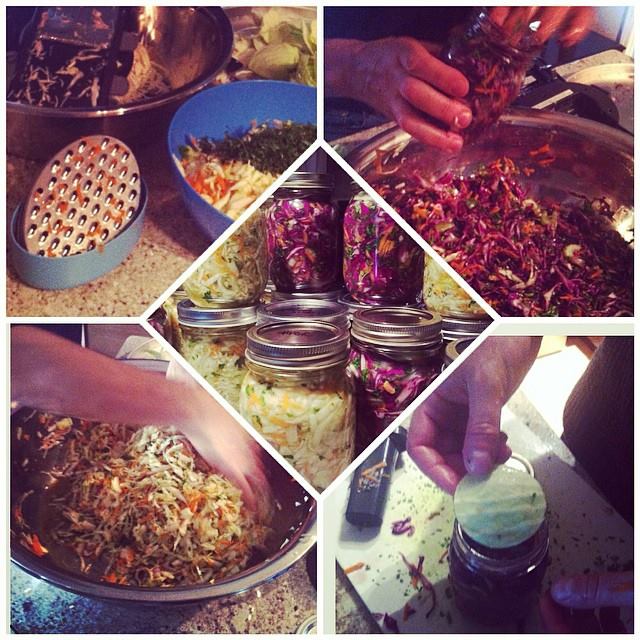This past Sunday my fam and I embarked on a new experience…fermenting vegetables (aka. The inaugural family ferment fest 2014). Fermented veg are an AMAZING source of probiotics, live microorganisms that confer numerous health benefits. Our body has 10x the number of bacteria as it has cells and our gastrointestinal tract is home to over 400 different species. Good bacteria help digestion, extract energy from our food, synthesize vitamins and nutrients, prevent growth of harmful bacteria, promote function of the immune system, and more. So it’s no doubt that maintaining an optimal balance of these guys is critical to our health.
Consuming fermented vegetables is a great way to ensure your body has the optimal balance of microorganisms…and this is how you can do it at home!
Supplies
– Cabbage
o Should comprise 80% of all veggies used.
– Celery
– Carrots
– Ginger
– Onion
– Parsley
– Hot pepper
– Starter culture – we used “Culture starter” by Body Ecology
– Mason jars
The vegetables listed are the ones we used. Other veggies used by experts include sweet potato, butternut squash, kale, collards, beets, granny smith apples, bell peppers, garlic, and other herbs such as thyme, rosemary, oregano, basil, sage.
Steps
- Juice celery. This will become your liquid base with which to host your starter culture. If you don’t have a juicer, you can use water + sugar instead of celery juice. See instructions on the package.
- Add ½ tsp of starter culture to approximately 4 cups of celery juice and let sit for 20 mins
- You don’t need a starter culture…the cabbage alone will kick off the fermentation process BUT having a starter culture increases the health benefits by having more bacterial strains present and increasing nutrient content ex. vitamin K2.
- Wash, peel and slice or shred vegetables. You can do this manually, using a mandolin or a food processor.
- Mix vegetables in a large bowl and make sure they’re all generously coated with the celery juice/starter kit liquid
- I’m more of an “eyeball it” kinda girl, so quantities are a little loose in the description. But we used 5 heads of cabbage, 7 carrots, ½ red onion, 3 inch root of ginger, 1 head of parsley for about 21 jars.
- Stuff the veggie mixture into mason jars, using a mallet/heavy spoon/juicer push stick to compress the mixture into the jar as much as possible.
- Pour off any excess liquid.
- Cover the top of the mixture with a spare cabbage leaf to create a seal.
- Screw the cap onto the jar loosely
- The bacteria will release carbon dioxide, so you want to leave room for air to escape. Other wise you risk cracking the jar.
- Move jars to a cool, temperature controlled area. Some suggest placing in a cooler.
- Let sit for 5-7 days or to taste.
- Move to refrigerator


